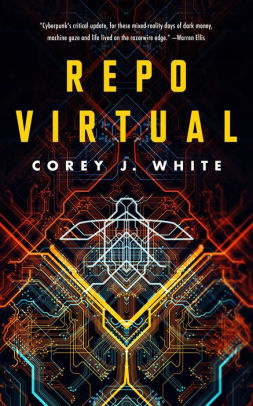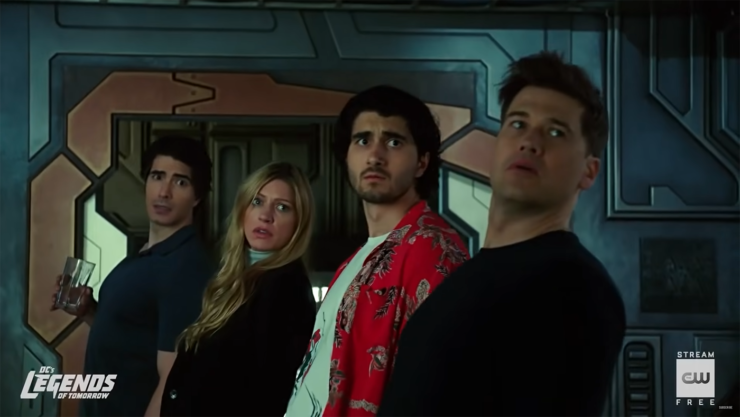If you don’t already watch Legends of Tomorrow, whatever kind of show you think it is, it’s not that. It’s too kooky, too adorable, too raucous, too frenetic, too earnest, too inexplicable, too wonderful, too cheesy to be contained. I’m full of warm fuzzies just thinking about it. Legends of Tomorrow is the kind of show that knows television can be fun and fresh and diverse and inclusive all at once. As season 5 kicks into high gear, I want to take a moment to celebrate a show we don’t talk about nearly enough.
If you know nothing of Legends of Tomorrow, let me give you a quick TL;DR. The lineup of the custodians of the chronology changes regularly but as of the season 5 premiere we have: BAMF Captain Sarah Lance (White Canary), Ava Sharpe (former Time Bureau director, current hot mess), John Constantine (master of the dark arts with enough baggage to fill the Grand Canyon), history detective Nate Heywood (Steel, and yes, I said history detective), Charlie (a shapeshifter recently escaped from Hell), stoner slacker Behrad (wielder of the Air Totem), perma-drunk Mick Rory (Heatwave), and cinnamon roll Ray Palmer (The Atom). Originally, the Legends were gathered to help a rogue Time Master defeat a supervillain. But as of late they have been chasing magical monsters and evil souls released from Hell and protecting history from those who would alter it for their own nefarious benefit.
My journey from Legends of Tomorrow hater to stan is a convoluted one. Having thoroughly enjoyed many of the characters from their exploits in the Arrowverse, I was excited for the premiere. Cue my supreme disappointment. Few seasons of television have made me angrier than season 1 of Legends, and halfway through I bailed out. The tone—halfway between the humor of The Flash and the grimdarkiness of Arrow—was off kilter with the premise. The writers wanted me to care about underdeveloped characters portrayed by underskilled actors standing around on cheap sets. I tried again with the season 2 premiere, but the last thing I wanted was yet another show full of mediocre cishet white dudes and token women and POC so I ditched out again. Sure, I watched the Legends crossover eps, but that felt like homework.
Buy the Book


Repo Virtual
Then came the jumbled, glorious mess that was NBC’s Constantine. I was DEVASTATED when it was cancelled in early 2015, but somehow it took me until summer 2019 before I learned that the CW had ported Matt Ryan onto Legends as a repeat guest. So I dipped my toe back in with a few of his eps from season 3. And then I watched a few more that he wasn’t in. And then a few more. And a few more after that. Before I knew it I was hooked. Back to the first season I went. Even though it was still rage-inducing, this time I could see how the writers were aiming for. Once the show moves past the dire Hawk-people vs Vandal Savage arc (and once the remaining actors settle into their characters), it embraces humor, charm, and out-of-this-world silliness.
Make no mistake: Legends of Tomorrow is a wildly goofy show. A 50 foot tall child’s talking stuffed toy named Beebo appears—twice. A character comes back from the dead with the magic of a group singalong. The Atom is chased through an air vent by a rat named Axel. Damien Darhk wanders around the timeline in increasingly ridiculous outfits and wigs. Gorilla Grod tries to kill a young Barack Obama. In one failed timeline, Sarah, Gideon, and Ava become the Time Bureau’s versions of Charlie’s Angels. A puppet is possessed by the soul of a dead serial killer. And that’s not even a tenth of it.
The show is zany, but it believes in the zaniness. For every bananas moment there are two more full of heart and sincerity. Each choice in the writers’ room is made with the best intentions toward the characters, setting, and story. Brick by brick, the writers have built a strong foundation. They have crafted an expansive world that straddles the line between deeply odd and unexpectedly believable. Season 5 has just begun and the writing has never been sharper; the actors are at the top of their game, cranking out stellar performance after stellar performance. It takes a lot of skill to pull off weirdly serious and seriously weird without overwhelming the audience or becoming unpleasantly camp, but every cast member has nailed it.
The show also leans in hard toward diversity. At first, it’s small but noticeable and by the fifth it’s delightfully obvious and integral to the structure. Across the CW, almost half of the 2019-2020 season regulars and two-thirds of the writers, directors, and executive producers on scripted shows are women and/or POC. The current Legends lineup has two Persian Muslims, two openly bisexual white characters, a white lesbian, a pansexual shapeshifter currently presenting as a Black woman, two white cishet guys who are openly and platonically affectionate, and another white cishet male character who started off as a toxic masculinity trope and has evolved into a dude who writes passionate romance novels under the nom de plume Rebecca Silver. Guest and background characters come in all shades of ethnicities and races. You can tell the difference between a company that just slaps a brown face on the cover of a book by and about white people and calls it “diversity” and one that builds an inclusive infrastructure by valuing and supporting diverse voices in front of and behind the cameras.
Legends is not perfect by any means. It could be better at representing the gender spectrum, body types, and disabilities, but at least it avoids stereotypes and offensive jokes. Black characters like Jackson and Amaya obviously experience life in the past different than white characters, but where many shows would either ignore the question or try to write around it, Legends tackles it head on. Sometimes it works, sometimes it doesn’t, but it’s rarely harmful. Early episodes struggled with how to discuss race and racism in sensitive and appropriate ways, but I appreciated that the writers didn’t just try but learned from their mistakes.
Endearingly bizarre, laugh-out-loud funny, mindbogglingly outlandish, and refreshingly candid, Legends of Tomorrow is the best of the CW superhero shows. For those of you who still refuse to give the scrappy little channel the credit it deserves, that won’t register as a compliment, but trust me, it is. All of the found family joy, supportive teammates going into battle together, surreal locations and scenarios, and biting social critique you love is waiting for you in Legends. Come to the dark side. Ray made cookies!
Alex Brown is a teen services librarian by day, local historian by night, author and writer by passion, and an ace/aro Black woman all the time. Keep up with her on Twitter and Insta, or follow along with her reading adventures on her blog.










